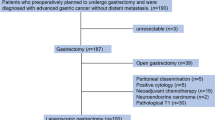Abstract
Background
Positive peritoneal fluid cytology predicts poor outcome in patients with resected pancreatic cancer. Reverse transcription–polymerase chain reaction (RT-PCR) has been proposed as a more sensitive means of detection of peritoneal micrometastases than conventional cytology. The clinical significance of RT-PCR positivity in the absence of other evidence of peritoneal disease is unknown. The purpose of the current study was to determine the outcome RT-PCR positive/cytology-negative patients who underwent potentially curative resection.
Methods
Peritoneal washings were collected prospectively from 115 patients with pancreatic cancer undergoing diagnostic laparoscopy at a single institution. Specimens were analyzed by a cytopathologist and by RT-PCR for carcinoembryonic antigen (CEA).
Results
Of the 115 patients, 62 (54%) underwent R0 resection. Eleven of the 62 patients (18%) had peritoneal washings that were negative by conventional cytology but positive for CEA by RT-PCR. Those 11 patients experienced early peritoneal and overall disease recurrence versus those who were RT-PCR negative (P = 0.001, P = 0.003, respectively) independent of nodal status.
Conclusions
RT-PCR for CEA is a sensitive and specific method for the detection of clinically significant peritoneal micrometastases from pancreatic cancer and it might identify a subgroup of patients with otherwise negative findings at staging laparoscopy who might respond better to treatment other than primary surgical resection.



Similar content being viewed by others
References
House MG, Fong Y, Arnaoutakis DJ, et al. Preoperative predictors for complications after pancreaticoduodenectomy: impact of BMI and body fat distribution. J Gastrointest Surg. 2008;12(2):270–8.
Williams TK, Rosato EL, Kennedy EP, et al. Impact of obesity on perioperative morbidity and mortality after pancreaticoduodenectomy. J Am Coll Surg. 2009;208(2):210–7.
Bentrem DJ, Brennan MF. Outcomes in oncologic surgery: does volume make a difference? World J Surg. 2005;29(10):1210–6.
Mayo SC, Austin DF, Sheppard BC, et al. Evolving preoperative evaluation of patients with pancreatic cancer: does laparoscopy have a role in the current era? J Am Coll Surg. 2009;208(1):87–95.
Soriano A, Castells A, Ayuso C, et al. Preoperative staging and tumor resectability assessment of pancreatic cancer: prospective study comparing endoscopic ultrasonography, helical computed tomography, magnetic resonance imaging, and angiography. Am J Gastroenterol. 2004;99(3):492–501.
Howard TJ, Chin AC, Streib EW, et al. Value of helical computed tomography, angiography, and endoscopic ultrasound in determining resectability of periampullary carcinoma. Am J Surg. 1997;174(3):237–41.
White R, Winston C, Gonen M, et al. Current utility of staging laparoscopy for pancreatic and peripancreatic neoplasms. J Am Coll Surg. 2008;206(3):445–50.
Tani M, Kawai M, Miyazawa M, et al. Liver metastasis as an initial recurrence has no impact on the survival of patients with resectable pancreatic adenocarcinoma. Langenbecks Arch Surg. 2009;394(2):249–53.
Jimenez RE, Warshaw AL, Fernandez-Del Castillo C. Laparoscopy and peritoneal cytology in the staging of pancreatic cancer. J Hepatobiliary Pancreat Surg. 2000;7(1):15–20.
Ferrone CR, Haas B, Tang L, et al. The influence of positive peritoneal cytology on survival in patients with pancreatic adenocarcinoma. J Gastrointest Surg. 2006;10(10):1347–53.
Yachida S, Fukushima N, Sakamoto M, et al. Implications of peritoneal washing cytology in patients with potentially resectable pancreatic cancer. Br J Surg. 2002;89(5):573–8.
Merchant NB, Conlon KC, Saigo P, et al. Positive peritoneal cytology predicts unresectability of pancreatic adenocarcinoma. J Am Coll Surg. 1999;188(4):421–6.
Greene FL. AJCC cancer staging manual. 6th ed.
Katsuragi K, Yashiro M, Sawada T, et al. Prognostic impact of PCR-based identification of isolated tumour cells in the peritoneal lavage fluid of gastric cancer patients who underwent a curative R0 resection. Br J Cancer. 2007;97(4):550–6.
Dalal KM, Woo Y, Kelly K, et al. Detection of micrometastases in peritoneal washings of gastric cancer patients by the reverse transcriptase polymerase chain reaction. Gastric Cancer. 2008;11(4):206–13.
Mori K, Aoyagi K, Ueda T, et al. Highly specific marker genes for detecting minimal gastric cancer cells in cytology negative peritoneal washings. Biochem Biophys Res Commun. 2004;313(4):931–7.
Reis-Filho JS, de Lander Schmitt FC. Fluorescence in situ hybridization, comparative genomic hybridization, and other molecular biology techniques in the analysis of effusions. Diagn Cytopathol. 2005;33(5):294–9.
Dalal KM, Woo Y, Galanis C, et al. Detection of micrometastases in peritoneal washings of pancreatic cancer patients by the reverse transcriptase polymerase chain reaction. J Gastrointest Surg. 2007;11(12):1598–606.
Shah D, Fisher WE, Hodges SE, et al. Preoperative prediction of complete resection in pancreatic cancer. J Surg Res. 2008;147(2):216–20.
Ahmed SI, Bochkarev V, Oleynikov D, Sasson AR. Patients with pancreatic adenocarcinoma benefit from staging laparoscopy. J Laparoendosc Adv Surg Tech A. 2006;16(5):458–63.
Yonemura Y, Endou Y, Fujimura T, et al. Diagnostic value of preoperative RT-PCR-based screening method to detect carcinoembryonic antigen-expressing free cancer cells in the peritoneal cavity from patients with gastric cancer. ANZ J Surg. 2001;71(9):521–8.
Nishiyama M, Takashima I, Tanaka T, et al. Carcinoembryonic antigen levels in the peritoneal cavity: useful guide to peritoneal recurrence and prognosis for gastric cancer. World J Surg. 1995;19(1):133–7.
Acknowledgment
The authors thank all participating attending surgeons at Memorial Sloan-Kettering Cancer Center (Dr. William Jarnagin, Dr. Vivian Strong, Dr. Michael D’Angelica, and Dr. Ronald Dematteo), as well as the operating room nurses and staff for their coordinated and diligent effort in specimen collection and processing, which made this study possible.
Author information
Authors and Affiliations
Corresponding author
Rights and permissions
About this article
Cite this article
Kelly, K.J., Wong, J., Gladdy, R. et al. Prognostic Impact of RT-PCR-Based Detection of Peritoneal Micrometastases in Patients with Pancreatic Cancer Undergoing Curative Resection. Ann Surg Oncol 16, 3333–3339 (2009). https://doi.org/10.1245/s10434-009-0683-2
Received:
Revised:
Accepted:
Published:
Issue Date:
DOI: https://doi.org/10.1245/s10434-009-0683-2




